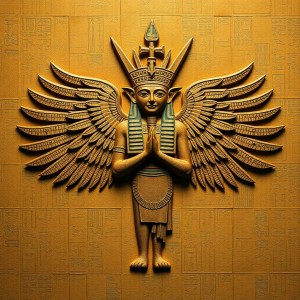Atenism and Its Cultural Impact on Neighboring Civilizations
I. Introduction
Atenism was a monotheistic belief system that emerged in ancient Egypt during the reign of Pharaoh Akhenaten in the 14th century BCE. This religious movement centered around the worship of the sun disk, Aten, which was seen as the sole god, contrasting sharply with the traditional polytheistic practices of the time.
The historical context of Atenism is rooted in a period of significant change in ancient Egyptian society, marked by political, religious, and artistic transformations. This article aims to explore the cultural impacts of Atenism on neighboring civilizations, examining its influence beyond the borders of Egypt.
II. The Rise of Atenism
A. The reign of Akhenaten
Akhenaten, originally known as Amenhotep IV, ruled Egypt from approximately 1353 to 1336 BCE. His reign is often highlighted as a pivotal moment in Egyptian history due to the dramatic religious reforms he enacted. Akhenaten is best known for moving the capital from Thebes to a new city, Akhetaten (modern-day Amarna), dedicated to the worship of Aten.
B. Key beliefs and practices of Atenism
Atenism was characterized by several key beliefs:
- The belief in Aten as the one true god.
- The rejection of other deities in the Egyptian pantheon.
- The emphasis on the sun’s role as a life-giving force.
- The promotion of direct communication with the deity, bypassing traditional priesthoods.
C. Transition from traditional polytheism to monotheism
The shift from polytheism to monotheism under Akhenaten was revolutionary. It dismantled centuries of established religious practices, leading to widespread upheaval in worship, as temples dedicated to other gods were closed or repurposed.
III. Atenism’s Influence on Egyptian Society
A. Changes in art and architecture
Atenism significantly influenced Egyptian art and architecture. The artistic style of the period became more naturalistic, moving away from the rigid forms of earlier periods. Key features included:
- Representations of Akhenaten, his family, and Aten in intimate, domestic settings.
- Innovative architectural designs, such as open-air temples that allowed sunlight to pour in, symbolizing the presence of Aten.
B. Shifts in religious practices and societal norms
The religious reforms led to a decline in the power of the traditional priesthoods. The cult of Aten prioritized personal worship over communal practices, altering the social fabric of Egyptian society.
C. Impact on the economy and political structure
Atenism’s rise also had economic implications. The closure of temples dedicated to other gods affected the economy, as these temples were centers of wealth and power. Politically, Akhenaten’s focus on Aten diminished the influence of the traditional elite, which led to further destabilization in the latter part of his reign.
IV. Atenism’s Reach Beyond Egypt
A. Trade and diplomatic relations with neighboring civilizations
Atenism’s impact was not confined to Egypt. Akhenaten established diplomatic ties with neighboring regions, including the Levant and Nubia, often utilizing trade as a means to spread Atenist beliefs.
B. Cultural exchanges with the Levant and Nubia
As trade flourished, cultural exchanges became inevitable. The artistic styles, religious concepts, and even political ideas spread beyond Egypt’s borders, influencing neighboring civilizations.
C. Spread of Atenist ideas through conquest and colonization
While Akhenaten’s reign was characterized by relative peace, subsequent conflicts and military campaigns helped disseminate Atenist ideas throughout the region, albeit with varying degrees of acceptance.
V. The Legacy of Atenism in the Ancient Near East
A. Adoption of monotheistic concepts in surrounding cultures
Atenism’s emphasis on monotheism left a lasting legacy on neighboring cultures. Elements of Atenist thought can be seen in the development of monotheistic religions that emerged later in the region.
B. Influence on the development of later religions
The philosophical underpinnings of Atenism may have influenced the development of Judaism, particularly in its early concepts of a singular, all-powerful God.
C. Atenism’s role in shaping philosophical thought
Atenism introduced new ideas regarding divinity and the relationship between humans and the divine, laying groundwork for future philosophical and theological discussions.
VI. Comparative Analysis: Atenism vs. Other Religious Movements
A. Similarities and differences with Judaism and Zoroastrianism
Atenism shares similarities with other monotheistic religions, particularly Judaism and Zoroastrianism, such as the worship of a singular deity. However, differences in practices, ethics, and the nature of the divine exist.
B. The impact of Atenism on subsequent monotheistic traditions
The ideas and practices of Atenism, particularly its monotheism, set a precedent that would influence the formation of later religions, including early Judaism.
C. Atenism’s unique characteristics in the context of ancient religions
Unlike many other ancient religions, Atenism was centrally focused on the worship of a single entity without an established priesthood, making it a unique case in the study of ancient belief systems.
VII. Modern Interpretations and Relevance
A. Atenism in contemporary scholarship
Modern scholars continue to explore Atenism, analyzing its significance and the implications of its monotheistic beliefs within the broader context of ancient religions.
B. Cultural representations in media and art
Atenism has found its way into contemporary media and art, inspiring works that reflect its themes of light, divinity, and the innovative spirit of Akhenaten’s reign.
C. The significance of Atenism in discussions of religious history
Atenism is a crucial component in understanding the evolution of religious thought. Its exploration provides insights into the dynamics of faith, power, and cultural exchange in the ancient world.
VIII. Conclusion
In summary, Atenism had a profound cultural impact, not only within ancient Egypt but also on neighboring civilizations. Its unique approach to monotheism and the changes it instituted in art, society, and politics marked a significant departure from traditional Egyptian practices.
The legacy of Atenism endures, as its influence can be traced through the development of later religious and philosophical thought. Studying Atenism is vital for understanding the complexities of ancient belief systems and their relevance in shaping modern cultures.
As we reflect on Atenism, we are reminded of the importance of examining ancient religions to better understand the foundations of contemporary spiritual and cultural identities.




